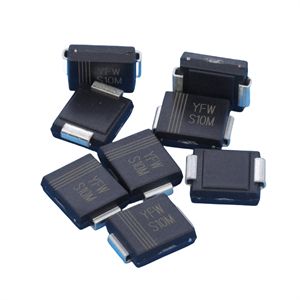Date:2024-09-23 Categories:Product knowledge Hits:925 From: Guangdong Youfeng Microelectronics Co., Ltd(YFW)
A bidirectional trigger diode is a special type of diode that has two PN junctions, allowing current to flow in two directions while also serving as a rectifying diode. This type of diode is commonly used for functions such as switching and protection in circuits, so it is very important. For testing bidirectional trigger diodes, the following methods can be used.
Method 1: Use a multimeter for testing
1. Preparation: Firstly, we need to prepare a multimeter and select the diode test gear. Select the PN junction diode test gear, usually marked with the symbol "diode".
2. Connection test: Connect the two pins of the diode to the test pins of the multimeter. Note that when connecting, make sure to connect correctly, that is, connect the positive terminal of the diode to the positive test terminal of the multimeter, and connect the negative terminal to the negative test terminal.
3. Test forward conduction: After the connection is completed, under normal circumstances, the forward voltage of the bidirectional trigger diode should be around 0.7V. By adjusting the knob of the multimeter, the test voltage can be gradually increased from 0V. When the value is around 0.7V, the multimeter displays conductivity (usually a small value), indicating forward conductivity.
4. Test reverse cutoff: Next, start testing the reverse voltage test. Reverse the test pins of the multimeter, connecting the pin originally connected to the positive direction of the diode to the negative direction of the diode, and the other pin to the positive direction of the diode. It should be noted that the connection between the positive and negative pins may vary depending on the type of diode, so please refer to the relevant product manual or data sheet.
On the reverse path, the bidirectional trigger diode should be in a high resistance state. When the test voltage reaches a certain level, the multimeter should display "open circuit", indicating reverse cutoff.
5. Result analysis: Through testing, we can judge the quality of the diode based on the display results of the multimeter. If the voltage during forward conduction is low, or if the voltage in the reverse path does not reach the expected value, or if the reverse direction does not reach the cutoff state, it may indicate that there is a problem with the diode.
Method 2: Use a digital multimeter for testing
A digital multimeter is a high-precision resistance meter that can be used to test current, voltage, resistance, etc. Compared to a multimeter, a digital multimeter has richer functions and more accurate measurements.
1. Preparation: Firstly, we need to prepare a digital multimeter. Set the multimeter to voltage mode and insert the measuring pin into the appropriate socket.
2. Connection test: Similarly, connect the two pins of the bidirectional trigger diode to the test pins of the multimeter. Connect the positive foot to the positive foot of the multimeter, and connect the negative foot to the negative foot.
3. Test positive conductivity: Similar to using a multimeter for testing, we gradually increased the test voltage and observed that when the value was around 0.7V, the multimeter displayed conductivity.
4. Test reverse cutoff: Similarly, we need to reverse connect the test pins. Connect the Domimeter pin that was originally connected to the positive pin to the negative pin, and connect the other pin to the positive pin. Please note that due to the special nature of testing with a multimeter, choosing the correct wiring method is crucial.
In the reverse path, the bidirectional trigger diode should be in a high resistance state. When the test voltage exceeds a certain value, the multimeter should display "infinity" or "open circuit", indicating reverse cutoff.
In actual testing, we should also pay attention to the following points:
1. First, confirm that you have correctly understood the definition and testing method of the bidirectional trigger diode pin, as well as the operation method of the device.
2. Before measurement, ensure that the bidirectional trigger diode has been unplugged from the circuit to avoid interference from other components on the test results.
If the test results do not meet expectations, you can try replacing a new bidirectional trigger diode for testing to determine if it is a problem with the diode itself.

Previous: Classification, Structure, and Principle of MOSFET
Next: What are the precautions for the application of Schottky diodes?